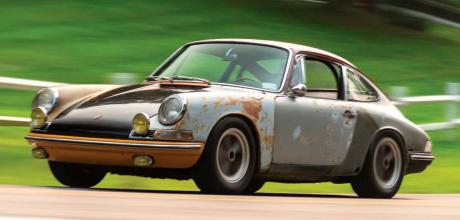Ryan Polson’s twice-smashed 1967 Porsche 912
Bought as a bargain-basement entry into 911 ownership, Ryan Polson’s 912 got chewed in a couple of crashes. Rehabilitated and endowed with a 2.2-litre flat-six, this arresting Porsche is busily morphing from rat-look to R-look…
Words Johnny Tipler
Photography Sean Smith
RAT TRAP
Aaargh! It’s not just the sound a traditional pirate utters. In the case of a Porsche, the R suffix can stand for Porsche’s first factory competition 911, the wonderful and exotic 911 R from 1967. Or, of course, it can be R for ratlook. As appearances go, this classic short-wheelbase 912 certainly exudes a scruffy, punkish charm. So, a bit of each, then. Let’s find out how it came to this. Back in 2018, Ryan Polson was living in Southern California. He was in the market for a Porsche and decided he wanted a classic, long-bonnet 911. “I really like the 1967 cars,” he tells us. “It’s pretty much the best year for a short-wheelbase model.” Mind made up, but then comes the reality check. “The goal, obviously, was to get a 911, but they were simply unreachable with the limited funds at my disposal. I ended up settling for a numbers-matching 912 advertised on Craigslist, but buying this car was a big mistake. I really shouldn’t have bought an old Porsche sight-unseen.”
HE SIMPLY HASN’T GOT AROUND TO HAVING THE CAR PAINTED AFTER ALL THE FRESH PANELS WERE GRAFTED IN
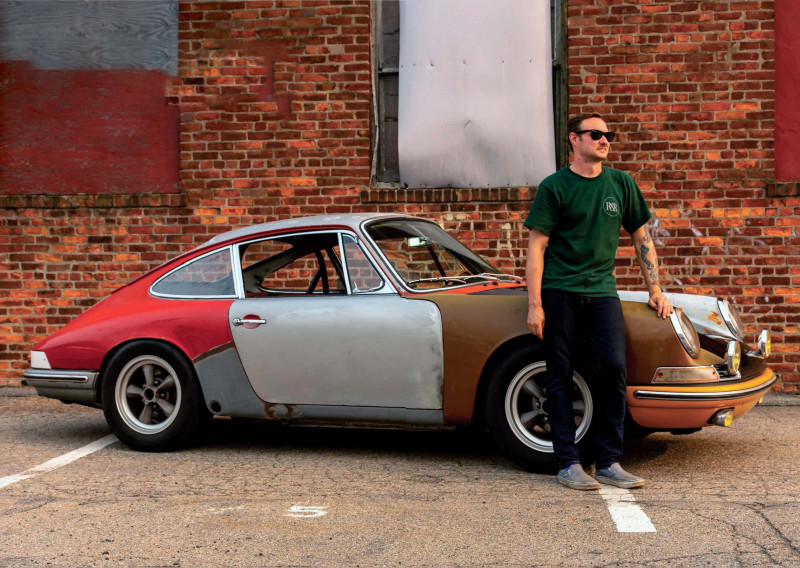
A special-order silver example of the four-cylinder ‘baby 911’, complete with red interior and five-gauge dash, the car was equipped with a five-speed transmission. This ought to have been a good jumpingoff point, but Ryan had been sold a Porsche with provenance a trifle murky. “I now have a copy of the factory Kardex to hand. It tells me the car was originally delivered to a co-op in Ohio, but I was never able to dig up any additional information on this front. Later, ownership passed to a guy in Denver. He owned the car for the vast majority of its life, until it passed to an Arkansas-based dealer, the very salesman who placed the Craigslist advert I spotted online. Sadly, the listing didn’t say anything about the presence of fibreglass wings. It also said this was a Californian car, which it clearly isn’t. There were many other false claims.” Lesson learned.

Having taken delivery, Ryan was kind of lumbered, but he was determined to make the best of things — he drove the little Porsche for two and a half years with the flat-four engine happily doing as it was told at the rear. “I drove the car to work and back every day because Californian weather allowed me to do so. I didn’t need another vehicle.” Unfortunately, two accidents in quick succession ensured his situation was set to change. “I was at a dead stop, when a guy in a Jeep backed into my 912. He blew the hood, fenders and caused loads of additional front-end damage. The second accident was when my wife and I were heading out for ice cream one night. I was driving along and bang! A car pulled out in front of me. I ended up T-boning it right in the side. I couldn’t avoid contact. I’d not long had my Porsche’s front-end patched up and now it was done in again.” Every cloud has a silver lining, as they say — accident damage and the subsequent insurance settlement gave Ryan the incentive to fix the nose of his car for good.
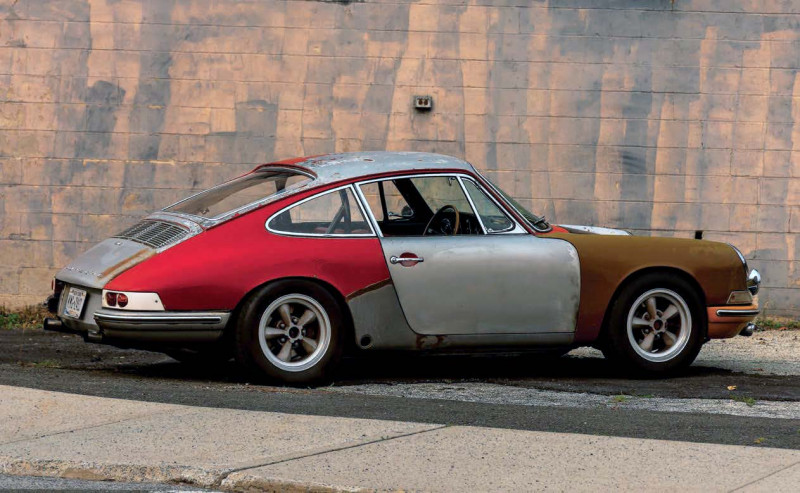
As we’ve already outlined, Ryan wanted a short-wheelbase, long-bonnet 911, but settled on a 912 due to lack of funds for the bigger-engined Porsche. “I liked driving the 912, but I always felt I was missing out on the magic of a flat-six. With this in mind, I vowed to buy a six-cylinder engine and convert the car to 911 specification.” Step back in time to 1967, when Ryan’s 912 was new. It cost $4,700. Compare this to the same-age 911, stickered at $6,500. Today, a pristine 912 could be $60,000 against a comparable 911 at double the price or more. Clearly, there is still a marked difference in values, largely on account of the two additional barrels. Engine aside, however, the classic 911 and the 912 are virtually indistinguishable from one another, making Ryan’s plan of action a sound proposition.
Another couple of years rolled by. Ryan was now living in upstate New York. He works out of R&R Automotive Restoration in Mount Kisco, Westchester County, New York State, a company specialising mostly in classic European sports cars from the 1950s and 1960s. The Mercedes-Benz W198 300 SL and Ferrari 250 GT are regular workshop visitors, as are vintage Maseratis and, of course, variations of 356.
The pandemic hit. Like many of us forced into lockdown, Mr Polson suddenly had time on his hands. He took advantage of the opportunity to get stuck into phase two of his 912 conversion project. “I was gathering all the parts together to change the car into a 911. I bought a 2.2-litre flat-six lifted out of a 1970 911 T and added to the parts pile with a neat exhaust system.” Obtaining the flat-six engine was the easy bit —getting the parts to fit, not to mention equipping the car well enough to run them, was the time consuming aspect of the project. “The engine mounts were from Restoration Design. Many other parts, including the oil tank, were used spares sourced through the early 911 S Registry. As the build progressed, I resolved to give the car something of a 911 R vibe, albeit with an unavoidably tatty look.”
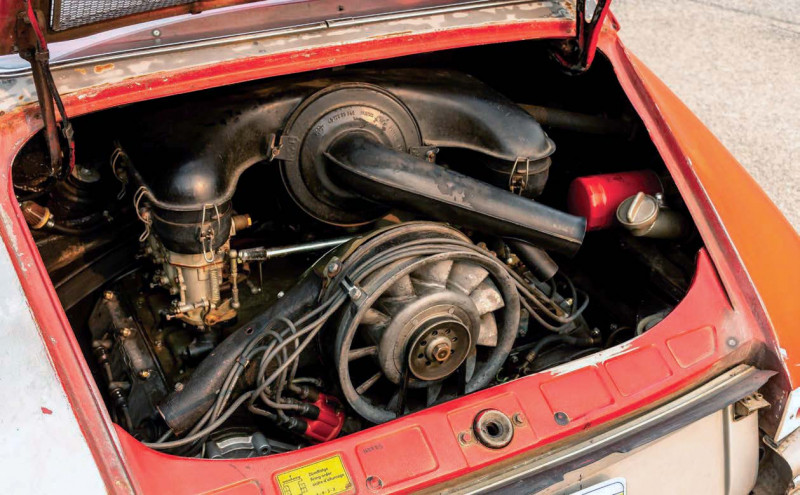
Other significant componentry he acquired included uprated dampers and a roll-hoop for the cabin. Elephant Racing adjustable rear spring-plates were fitted, as were five-spoke American Racing Torq Thrust fifteeninch staggered aluminium wheels shod with 205/85 BF Goodrich Advantage T/A tyres. “I was away from work for a month or so due to the government-mandated restrictions on movement we all endured. During this time, I got the car working with its new engine. It took three days of toying with the flat-six and trying to get it to sit happily in the back of the 912, but it’s been working without fault ever since.”
Great, but what about the bodywork? “After the collision with the Jeep,” Ryan continues, “I bought brandnew reproduction panels from a well-known brand, but the fit was terrible. I suppose you could argue it was ‘lucky’ the car got hit again, giving me insurance money to spend on original used Porsche parts — I bought rotfree 911 panels second time around. As you’d expect, they fit perfectly.” And the different colour paintwork? “I’ve never really been a guy who’s wild about cosmetics. I’ve always been more about the function of a car.
This has been a good project and I’ve really enjoyed the mechanical work, but I just don’t have the time or resources to paint my Porsche, not that this concerns me — I’m enjoying it as is, complete with 2.2-litre 911 power.” Talking of mechanicals, Ryan reckons they’re pretty much bulletproof. “Honestly, this Porsche hasn’t yet let me down. I’ve never been stranded. I added at least forty-thousand miles to the odometer with the flat-four in place, plus a further fifteen thousand since the six-cylinder engine was bolted into place.” A mechanic by trade, it comes as little surprise to learn he decided to take care of the workings of the car first, leaving the finer detail for another day.
There’s method in his 912 project madness: going a route inspired by the stripped-out R means he doesn’t have to worry about 911 minutiae, such as trim likely in need of re-chroming or fettling. “The minimalist approach makes this a cheaper car to restore,” he says. “Instead of having to send out all the little bits to specialist shops for expensive corrective work, the parts can be completely excluded. I could probably sell them, using the money raised to buy items I can bolt right on.” Needless to say, the work he’s carried out on his 912 is relatively simple and straightforward when compared with the jobs he’s tasked with taking care of on the high-end classics providing him with a pay cheque each month.
MAKING THE SWITCH
For some, engine swaps are a way of life. I’ve taken a humble Alfa Romeo Giulia TI from 1,300cc to 2,000cc in three stages, swapping ever larger capacity twin-cam motors. My 964 received a new flat-six when its original powerplant’s crankshaft snapped. In truth, popping out a flat-four and shoehorning in a six-cylinder boxer isn’t a big deal in these days of Porsche restomod culture, but is the end result really worth all the effort? “It is if you want to keep up with modern traffic,” laughs Ryan. “The first time I drove the car with the new engine installed, it felt like I’d equipped an old Volkswagen with rocket power. It made me realise just how slow the 912 was with its original engine in place. I immediately felt able to drive the car assertively. Moreover, I could execute overtaking moves in safety. There’s also no longer an excuse for me to miss scheduled appointments!”
Obviously, you don’t do something as radical as an engine swap without assessing the possible negative consequences. Obviously, there is more weight at the back end of a 912 with the 911 engine installed. “You definitely feel the extra bulk,” he confirms, musing over the Porsche’s altered chassis dynamics. “The main difference is how I felt I could drive the car a lot harder with the flat-four in place, even though the car was much slower. To my mind, however, the 912 is too slow, even though the balance of weight across the car is much better than it is on a 911 of a similar vintage, or indeed a 912 with a flat-six tucked away at the rear. Additionally, a standard 912 doesn’t sound as good as a 911 — the noise of the engine is too close to that of a Beetle for my liking.”

Many of you will be wondering if, along with the power upgrades, he’s beefed up the brakes. “Really, the only difference between the 912 and the 911 is the engine, its mounts and the bigger-displacement Porsche’s rear anti-roll bar. Obviously, both models share the same body shell, though the 911 S featured bigger brakes. My 912 is a 1967 build. The equivalent 911 S delivers close to 160bhp, whereas the later 2.2-litre 911 T, the very model my car’s flat-six comes from, makes roughly 123bhp. The 912’s brakes are more than up to the job of handling this modest level of output. I put new Weber carburettors on the engine, attached the aforementioned exhaust system and that was it. I run the unit close to how it left the factory.”
Fair enough, but was he not tempted to install a 911 S engine? The answer is laced with pragmatism. “When it come to classic 911 S engines, there’s cost and availability to be concerned with. The good thing about the easier-to-obtain 2.2-litre 911 T flat-six is how it is a low compression unit. It’ll go on forever. In the ideal world, my plan would be to do more parts gathering and assemble a twin-plug two-litre or even a 2.2 unit, more or less the same configuration as the 911 R. Alternatively, I’d try to find a mechanical fuel-injection motor to install, but it’s all money.” In my own experience, the 2.2-litre unit loves to rev and produces the most gorgeous flatsix sound. “Oh, yes, indeed! A flat-six at 6,500rpm is so much better than a flat-four at 4,000rpm,” Ryan grins, appreciating there’s nothing more spinetingling than an early flat-six on full song — that banshee howl totally curdles the blood.
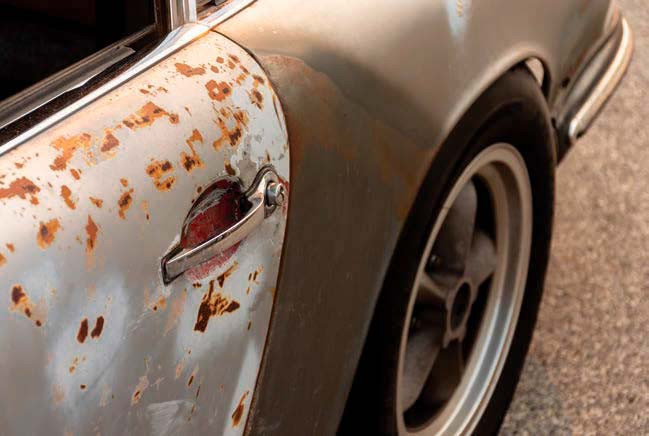
This is the first Porsche Ryan has owned. Perhaps unsurprisingly, he previously drove homegrown American V8s, majoring on the 1930s and vintage hot-rods. “I also owned a 1963 Beetle, which I drove during my time at high school,” he admits. “That car is still in my family today. Time behind the wheel of the Volkswagen is how I’m able to make a valid comparison between the Beetle and the 912, though I admit the Porsche is a little bit faster than the VW, even if both cars share the same soundtrack.”
Working, as he does, on exotic classic cars, he has an eye focused on practicality, or lack of it, in certain cases. The Porsche, he believes, falls into the practical category. “The 911 is a very usable car, certainly in terms of how you can drive a classic 911 or 912 every day. Importantly, spare parts are readily available, and Porsche’s air-cooled boxers don’t guzzle fuel like an American V8. The 912 is also a popular Porsche for people who want to take their first step into classic sports car ownership. With this in mind, despite the problems I endured after buying my car, I felt safe taking it on because I knew I wouldn’t have trouble selling up, if necessary.” Somehow, I don’t sense that eventuality coming along any time soon.
I ask about plans for the car’s interior. Does Ryan intend to fashion it along the lines of the uber-basic 911 R? The answer is in the affirmative. “I’m going to strip it out. I intend to fit lightweight fibreglass doors and fit R-style seats. I’ll probably leave the headliner in and fit some rear carpets, but I also hope to install lightweight polycarbonate windows. For the most part, I’m trying to strip the car down to its bare essentials. There’s no heater, for example. None of this will happen overnight, you understand. It’s a long-term project.” To this end, with limited finances to play with, paintwork will come much later, if it at all.
DRAWING ON HISTORY
He ponders the matte finish of bare fibreglass, but then again, some modern finishes are matte anyway. In any case, he’s certainly heading in the right direction in taking influence from the 911 R. His 912’s rear lights, for example, look exactly like the 911 R components sourced from the NSU parts bin.
Lightness was (and still is) everything for Porsche at the race track. Incidentally, the distinctive circular lamps were sourced from TRE Motorsports in California, as was the rollover bar.
Essentially, what we’re looking at is an air-cooled Porsche previously subjected to damage, subsequently mended and modified, but a car yet to be painted. It’s all polyglot hues, textures and finishes — a classic rat-look contender. You can see what might have sparked the idea. The look was born in Southern California, where Ryan was living when he bought the Porsche, and is very much beloved of classic Beetle and Bus owners whose rides are slammed to ground-scraping levels. It’s not exclusively the province of Volkswagens, mind you. For reasons best left unsaid, I once owned a Ford Anglia 105E, which through no fault of its own had descended into the rat house. You can have a motorcycle equivalent, too: the rat bike. Its defacement is achieved by the deliberate blemishing and neglect of the vehicle’s paint finish, the addition of non-original componentry and, if you really want to go to town, a concerted distressing of the entire exterior. In some artistic cases, facsimile rust is actually painted onto the surface of the bodyshell. Two fingers to the establishment.
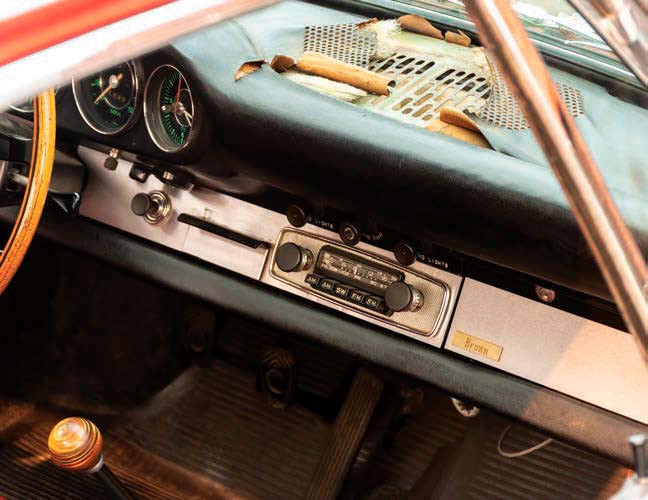
Ryan’s 912 steers a middle course insofar as he simply hasn’t got around to having the car painted after all the fresh panels were grafted in. And, chances are, he won’t get it painted, either. This may be no bad thing. If the 911 R look is what he’s after, he would do well to bear in mind race cars in the 1960s could be rough and ready in appearance, even if they were well screwed together, which is certainly the case here.
Look at it this way: while we understand a classic car of this nature is not to everyone’s taste, it’s a breath of fresh air in a world striving for Porsche perfection and, like a studded Mohican punk in the mosh pit, it’s challenging. Distressed, in a SoCal sense, is certainly cool. Man and machine are in a win-win situation. All Ryan needs to do is avoid another accident. What’s that old adage about everything coming in threes?!
Above Regardless of whether you rate or hate Ryan’s in-progress Porsche, there’s no denying his passion for the car, despite it repeatedly causing him grief.
IN MY OWN EXPERIENCE, THE 2.2-LITRE UNIT LOVES TO REV AND PRODUCES THE MOST GORGEOUS FLAT-SIX SOUND
Above Following the installation of ill-fitting aftermarket panels, Ryan has been investing in good-quality used original Porsche panels, hence the multi-coloured ‘rat rod’ look of his 912.
Above and below Interior is just as tatty as the exterior, but Ryan is more concerned with how well the car drives thank its looks.
GOING A ROUTE INSPIRED BY THE STRIPPED-OUT R MEANS HE DOESN’T HAVE TO WORRY ABOUT 911 MINUTIAE
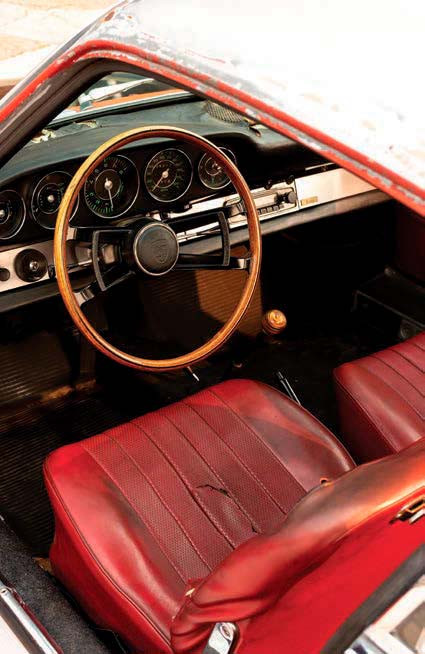
Above 2.2-litre flat-six gives the car a significant hike in horsepower over the previously installed flat-four.
Above This distinctive 912 has tested Ryan’s patience time and again, but he’s sticking with the car, which is being afforded a new lease of life following two smashes.
Below R-style rear lights indicate (geddit?!) the direction of the project.


